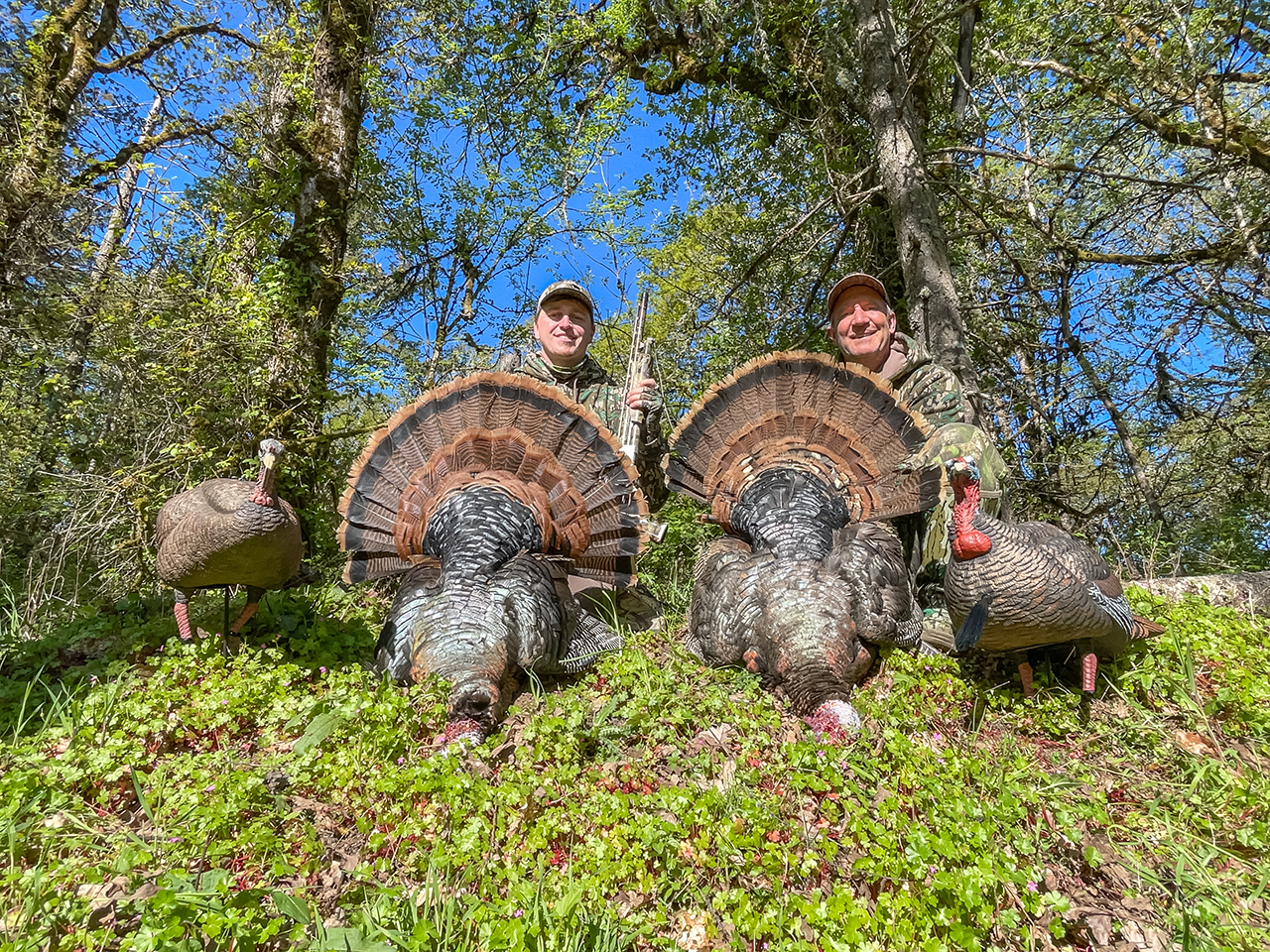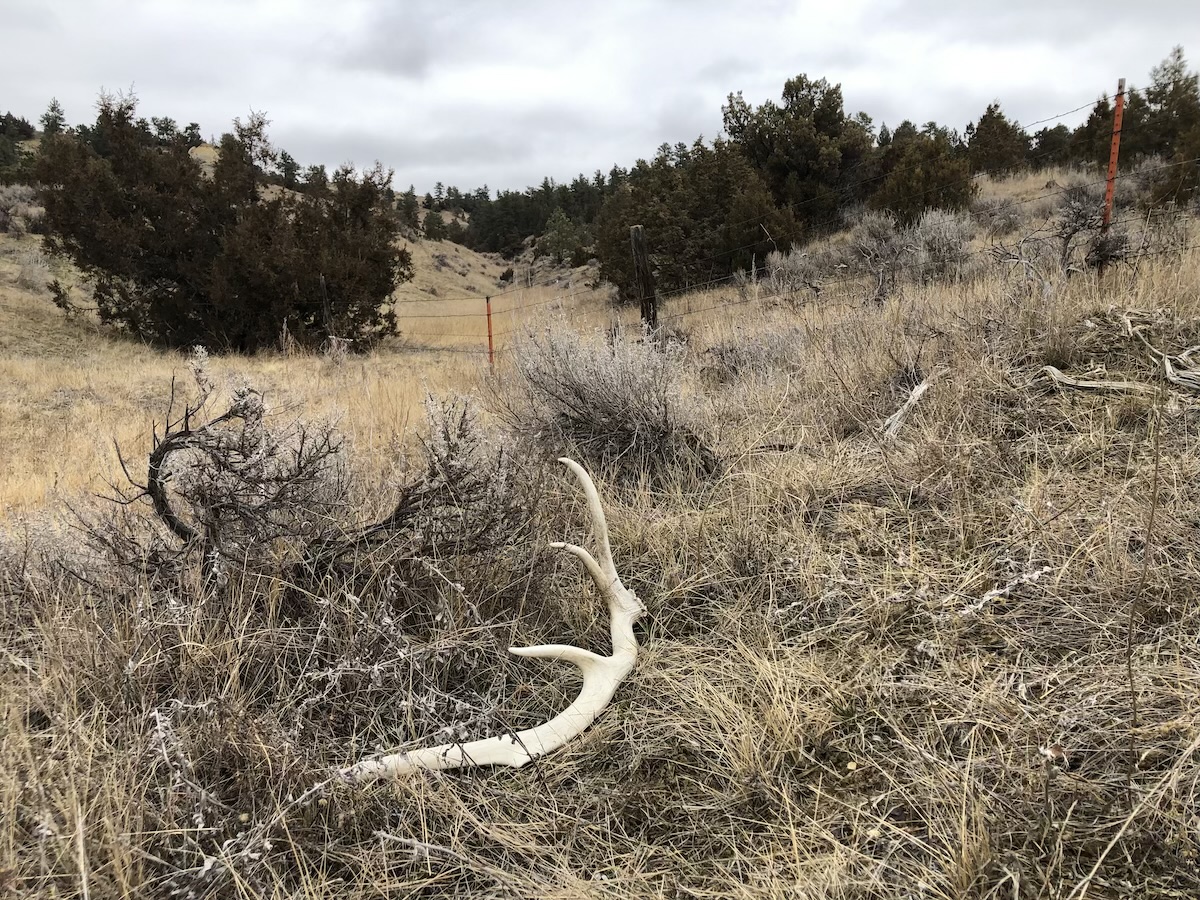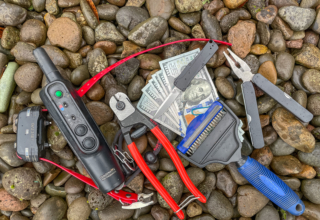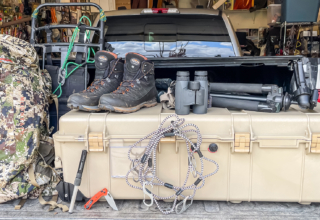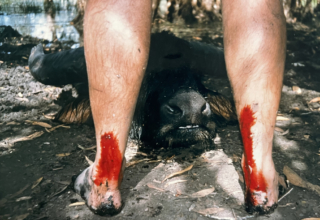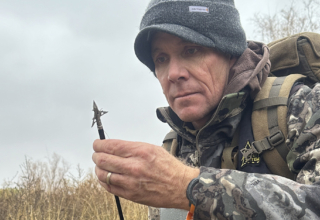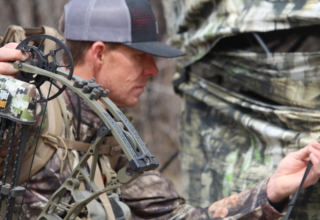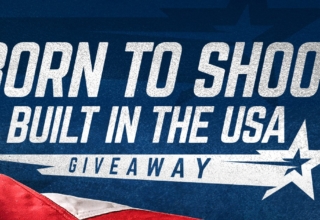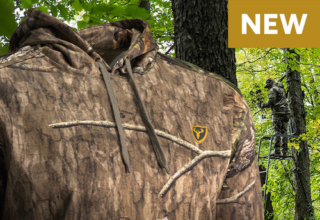Trail cams are arguably one of the most critical hunt/scout advancements ever, and the more CREATIVE you get with your cams, the more animal intel you’ll gather. Here’s what you need to know.
by Scott Haugen
I’ve been using trail cameras since their film-style birth. I love them. These tools give me a complete understanding of animals and animal behavior and they have made me a better hunter. What I would have given to have trail cams when I started hunting and running a trapline in the mid-1970s.
I run over 50 trail cameras year-round. Only six of them are transmitting cameras, and those are for predator control. I have to check the others manually. I do it at least once or twice a week when the rut, hunting seasons, and migrations are underway.
Managing so many cameras requires organization, and these tools have helped maximize my trail camera efficiency.
A Better Backpack
When Alps Outdoorz came out with their Motive backpack, my trail camera management hit new heights. For the first time, I could safely secure and carry multiple trail cameras and necessary gear in a backpack designed specifically for this purpose. Eight trail cameras fit into this pack, and the padded dividers can be adjusted to optimize fit and maximize space.

I like the mesh side pockets to hold a water bottle and a machete. A front accessory pocket allows storing multiple gear pieces, from extra batteries to cable ties, shears to swabs, a headlamp, and more.
The main compartment has a large, zippered, mesh pocket for more gear. Above that are 16 SD card slots for quick, easy access. The bar-tacked webbing allows multiple items to be attached to the outside of the pack, including gloves, LoopRopes, LoopClips, a hatchet, and more. This pack is comfortable and functional. I hope they create a more extensive version; I could use it.
Hydrate
The other day I went out to set up 13 cameras. I was planning on being home before lunch. Eleven hours later, I returned. I found a place where elk were living and kept going. That day, set over 20 trail cameras. I returned to the truck several times to get more cameras and snacks. In addition to the snacks, I refilled my Yeti Yonder Water Bottle multiple times. The 20-ounce Yonder is a nice size for the backpack, and I like the Chug Cap option. The bottle is sturdy and quiet. I no longer take cheap, noisy, store-bought plastic water bottles afield. I like it so much that I started using their new 1.5-liter Yonder Water Bottle, which I love for dog training and road trips.
Cut It Down!
I sometimes create elaborate sets for my trail cameras, often taking an hour or more to complete. One of my most essential pieces of gear is a machete. One I’ve had for over a decade. It’s since been discontinued, but it’s heavy, has a sharp point, and a 20″ blade. This machete is perfect for mowing down the grass, berry vines, and other brush. It’s good for hacking down limbs up to two inches in diameter. I also use it to open, build and maintain trails in the spring and early summer when vegetation rapidly grows. When walking trails, this is the machete I always have out, chopping and clearing new growth.
Browning’s Brush Craft Camp machete is the second model I rely on. This tool is a workhorse and is great for digging, breaking up old logs, and cutting vines and small root wads that can be toe-grabbers. This bowie-style knife is compact, 15 inches long, and suitable for keeping trails open once groomed. It’s lightweight and easy to pack.

More Sharp Tools
I’m not going to tell you how many knives I have —another addiction — but if I had one to take on trail camera missions, it’s Benchmade’s Bushcrafter. I’ve used the Bushcrafter to cut tall grass, slice berry shoots, sever poison oak vines, dig out old logs to make recessed camera sets, and chop green alders and willows over an inch in diameter. I’ve dug deep into the dirt and rocky ground, split limbs and chiseled bark to tether trail camera straps. I have even made shims from limbs to wedge trail cameras into precise positions. The weight, balance, and sharp steel make the Bushcrafter the most functional and versatile knife I’ve used for managing trail cameras. It’s a great knife to have in any camp.

I also use Browning’s Outdoorsman Compact Hatchet for taking down limbs, cutting suckers, and chopping roots that impede trails. I’ve chopped fallen tree parts to wedge a trail camera beneath it. I clip the hatchet sheath to the top carry loop on the Motive backpack, then slip the hatchet handle into one of the mesh pockets. This makes for secure carrying and simple access.
I also have a folding saw and pruning shear in my pack. The other day a small tree fell across one of the trails I have multiple cameras set on for elk, and I used the folding saw to remove it. I’ll often carry the pruner in my pocket to snip branches and briars closing in on trails or in front of cameras I already have set.
Cable Ties & LoopRopes
Because I tailor many trail camera sets, I often use cable ties to secure support sticks for the camera. I’ll use extensive cable ties to join multiple willow or alder limbs in places. This makes a stable platform I can hang any trail camera on. Duct tape can also come in handy when creating specialized sets.
Sometimes I tether thick limbs, driftwood, or multiple rotten logs together to secure a trail camera. Often they’re standing upright in water to capture waterfowl or furbearers. Other times they’re laying across a trail to get deer or elk stepping over them. I’ll also lash together a base when setting cameras on tundra river banks in Alaska to get brown bears and wolves passing by. To create these stands, I use LoopRopes, a lot. If you’ve not heard of the LoopRope, you’ll love them. I’ve been using them for over a decade for trail cameras, hunting, fishing, camping, and more. The multiple loops on a LoopRope allow for a range of fastening options that will enable you to customize the fit.

LoopRopes are stronger and more functional than a single-strand bungee and are an essential tool I rely on. The LoopClips that come with the LoopRopes are dual-ended clips that optimize securing points. I use the LoopClips to attach a range of gear on the bartacks outside of my Motive pack.
Other Trail Cam Accessories
As for accessories in my Motive pack, I carry at least two dozen extra SD cards. I run all my trail cameras on video mode, so I use 64GB 10-class cards reading at 130 MB/second. If putting the card inside the loops in the backpack, I put each in their little case to keep them clean. I also have two card cases; one holds 8 cards I put in a pocket for quick camera checks and card changes, and another holds 26 SD cards for those long days when I’m checking many cameras. I also carry a couple dozen extra AA batteries.

Also in my pack is a small towel to wipe dust, dirt, water, and ice from trail cameras and a few cotton swabs to dig out cobwebs. Some of my camera sets on the ground get covered in mud when a herd of elk moves over them, and keeping all working parts clean, is a must. To optimize the clearest video clips, I make it a point to clean the front of my cameras every time I check them.

Gloves are essential for the many thorny vines and stiff grass I deal with year-round in my area. I go with bright, cheap gloves with rubber grips, which are easy to find when I drop them yet durable enough to get the job done.
Better Boots
Covering miles in the woods weekly when running trail cameras is an excellent opportunity to test clothes and boots that could be ideal for future hunts. Footwear is one of the most critical items when running trail cameras and hunting, and over the past few months, three have caught my attention.
First is Meindl’s Comfort Fit Hiker. I’ve been a longtime fan of Meindl boots and have worn them on big game hunts worldwide for many years. The Hiker confirms why I love the Meindl line of boots. Comfortable, light, and tough, I wore this boot many days in rugged, rocky terrain. It’s a durable boot that can take a beating on rocky, hard ground. It’d be a perfect early-season big-game boot.
I’ve also worn several LaCrosse boots over the decades, including their winter wear models when running a 200-mile wolf trapline in Alaska’s Arctic. Of all the boots I’ve worn, their new Ursa MS is the best technical hunting boot they’ve ever made. Light, durable, and ergonomic, the Ursa is more like wearing high-top sneakers than hiking boots. The comfort and ankle support are top-notch, and the sleek soles ensure you’re not kicking rocks or protruding roots. I’ve logged many miles in these boots, and they continue to impress
me.
I set many trail cameras in mountain creeks and swamps in the summer, places with too much water for knee boots but not enough to warrant wearing waders. Enter Chêne Gear’s new Slough Boot. The boot is comfortable and offers excellent ankle and arch support, just like their knee boots and waders. But the nylon material with the elastic band at the top is where this Slough Boot shines, bridging the gap between knee boots and waders; they’re lightweight and breathable. The adjustable webbing clip is versatile, functional, and efficient. Not only are these boots great in water, but they work for wading through dry grass over my head, keeping grass seeds from getting into the boot.
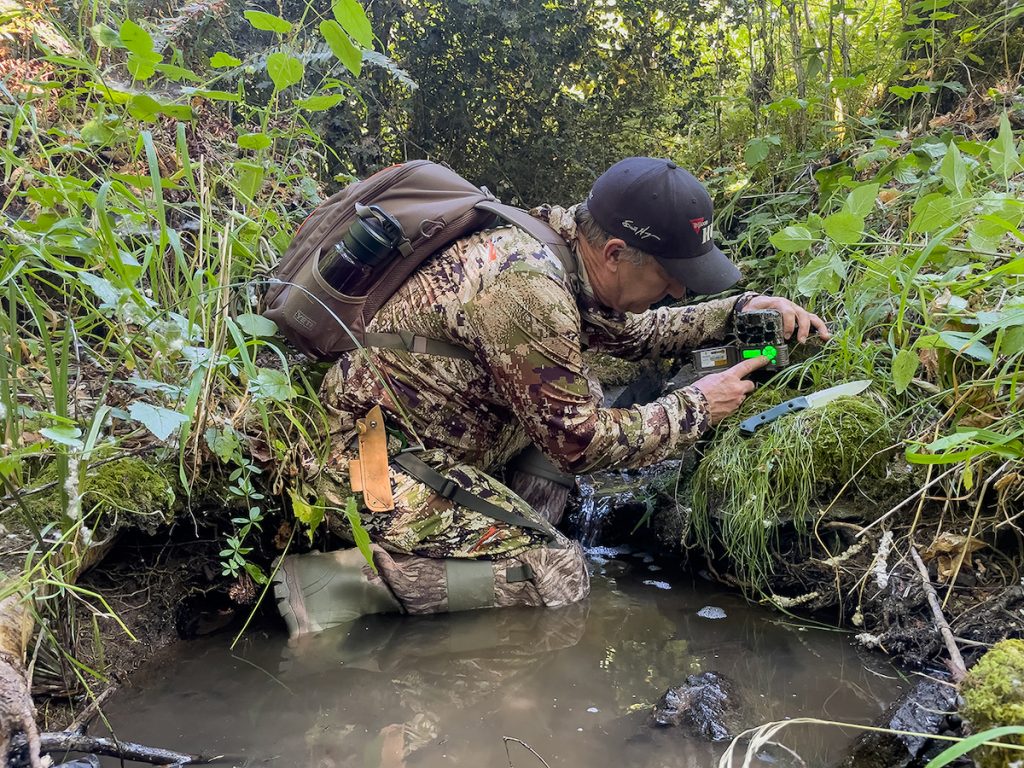
Proper Pants
I position many trail cameras on the ground, so I am often on my hands, elbows, and knees. The first time I wore Sitka’s new Intercept pants and hoody into the trail camera woods, my life instantly got better. The padded knees and elbows of the Intercept line are a game-changer, making rough situations comfortable with no more bruises, aches, and pains. Maybe it’s because I’m getting old, but the Intercept collection is a simple luxury that I appreciate. I’ll wear these on upcoming big game hunts, and they’ll go with me on my next trip to Africa.
Map Those Cams
One final tool that can help manage your trail camera efforts is onX. I use it to mark camera waypoints as I’m always moving and adding cameras, which helps me keep track of them. Soon, onX will be delivering Trail Camera Integration and management tools to help those who like running cellular cameras, so keep an eye out for that.
There you have it, the tools I rely on to take my trail camera game to the next level. As a full-time writer and photographer, trail cameras are my eyes in the woods when I’m not there, and the more cameras I can have out there and the more efficiently I can manage them, the better.



